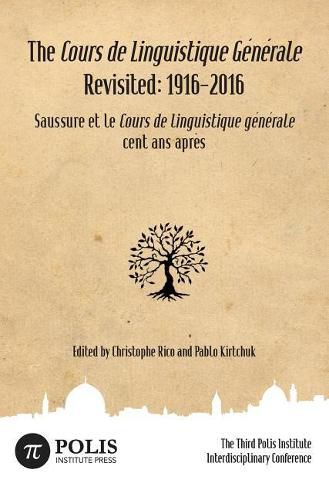Readings Newsletter
Become a Readings Member to make your shopping experience even easier.
Sign in or sign up for free!
You’re not far away from qualifying for FREE standard shipping within Australia
You’ve qualified for FREE standard shipping within Australia
The cart is loading…






This title is printed to order. This book may have been self-published. If so, we cannot guarantee the quality of the content. In the main most books will have gone through the editing process however some may not. We therefore suggest that you be aware of this before ordering this book. If in doubt check either the author or publisher’s details as we are unable to accept any returns unless they are faulty. Please contact us if you have any questions.
In 1916, three years after the death of Ferdinand de Saussure, the Cours de linguistique generale (CLG) was published in Geneva. This foundational work marked the beginning of a discipline that has profoundly influenced the development of the humanities ever since.
What sources influenced the CLG? Do the main concepts of this seminal work have the same validity today as they did in 1916? How has the recent development of language sciences influenced its reception? How does this text account for meaning and communication within the context of speech (parole)?
In order to explore these questions, one hundred years after the publication of Ferdinand de Saussure’s seminal work on General Linguistics, Polis–The Jerusalem Institute of Languages and Humanities held an interdisciplinary conference that gathered 14 international specialists from various disciplines: general linguistics, pragmatics, philology, dialectology, translation studies, terminology, and philosophy.
The first section of this work reassesses the sources and further influence of the CLG on modern linguistics. The book’s second part discusses some of the main concepts and dichotomies of the CLG (constitution of the linguistic method, arbitrariness of sign, main dichotomies), under the light of both the original manuscripts and recent linguistic developments (influence of dialectology or translation studies). The third and last part handles the pragmatic and semantic dimensions of language, suggesting new avenues of reflection that could not yet have been fully taken into account within the CLG itself.
Uniting 14 scholarly articles, together with an introduction, an index locorum and a collective bibliography, this volume hopes to encourage readers with its reappraisal and reinterpretation of Saussure’s ground-breaking work and thus contribute to the future development of linguistics and humanities.
$9.00 standard shipping within Australia
FREE standard shipping within Australia for orders over $100.00
Express & International shipping calculated at checkout
This title is printed to order. This book may have been self-published. If so, we cannot guarantee the quality of the content. In the main most books will have gone through the editing process however some may not. We therefore suggest that you be aware of this before ordering this book. If in doubt check either the author or publisher’s details as we are unable to accept any returns unless they are faulty. Please contact us if you have any questions.
In 1916, three years after the death of Ferdinand de Saussure, the Cours de linguistique generale (CLG) was published in Geneva. This foundational work marked the beginning of a discipline that has profoundly influenced the development of the humanities ever since.
What sources influenced the CLG? Do the main concepts of this seminal work have the same validity today as they did in 1916? How has the recent development of language sciences influenced its reception? How does this text account for meaning and communication within the context of speech (parole)?
In order to explore these questions, one hundred years after the publication of Ferdinand de Saussure’s seminal work on General Linguistics, Polis–The Jerusalem Institute of Languages and Humanities held an interdisciplinary conference that gathered 14 international specialists from various disciplines: general linguistics, pragmatics, philology, dialectology, translation studies, terminology, and philosophy.
The first section of this work reassesses the sources and further influence of the CLG on modern linguistics. The book’s second part discusses some of the main concepts and dichotomies of the CLG (constitution of the linguistic method, arbitrariness of sign, main dichotomies), under the light of both the original manuscripts and recent linguistic developments (influence of dialectology or translation studies). The third and last part handles the pragmatic and semantic dimensions of language, suggesting new avenues of reflection that could not yet have been fully taken into account within the CLG itself.
Uniting 14 scholarly articles, together with an introduction, an index locorum and a collective bibliography, this volume hopes to encourage readers with its reappraisal and reinterpretation of Saussure’s ground-breaking work and thus contribute to the future development of linguistics and humanities.